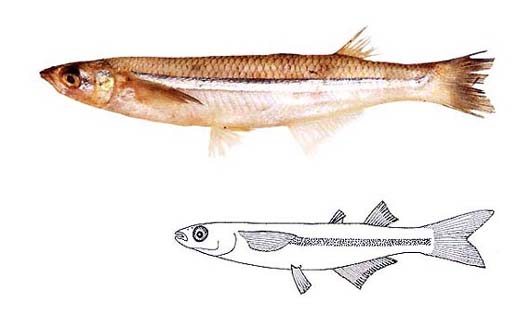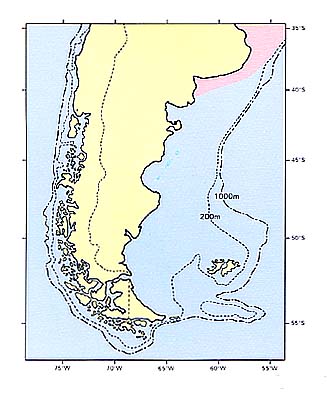トウゴロウイワシ科
- HOME
- デジタル図鑑
- パタゴニア海域の重要水族
- 硬骨魚綱 トウゴロウイワシ目 トウゴロウイワシ科
トウゴロウイワシ科(Atherinidae)

External feature (after Figueiredo and Menezes, 1978).
52 ラプラタトウゴロウ(Rapurata-tougoroo)
Odontesthes bonariensis (Valenciennes, 1835)
Pejerrey, Pejerrey de mar, Baboso (Arg.); Peixe rei(Br.)
特 徴:
第1背鰭5棘,第2背鰭1棘,9軟条,臀鰭1棘,18~22軟条,胸鰭13~14軟条,腹鰭1棘,5軟条,鰓耙数6~8+17~21=23~29,縦列鱗数54~56。体長に対する体高の割合は17.5~18.4%。頭長は20.7~21.5%,胸鰭長は20.5~21.0%,腹鰭長は9.8~10.9%,尾柄高は8.4~9.3%。頭長に対する眼径の割合は19.0~23.1%,両眼間隔は33.3~38.4%,吻長は33.9~34.9%,上顎長は27.8~29.9%。体は側扁するが,頭部はやや縦扁し,頭部背面は平坦。尾柄は高く,強く側扁する。口は小さく,主上顎骨の後縁は下方に湾曲し,眼の前縁下に達しない。上顎は下顎より前方に突出する。眼はやや大きく,頭長の1/5~1/4。胸鰭の先端は腹鰭基底上に達する。肛門は臀鰭起部の直前に開く。側線はない。鱗は大きな円鱗。体側の上方は青褐色で,下方は銀白色。体側は中央に胸鰭基底から尾鰭基部に達する銀色の太い縦走帯があり,その上縁は暗青色。頭部背面,胸鰭および尾鰭は黒味をおびる。
分 布:
ブラジルのサントス付近からウルガイにかけての極く沿岸域に分布する。
備 考:
本種の仲間は一般にペヘレイと呼ばれ,アルゼンチンでは重要な食用魚となっている。また,近年,淡水性のものが養殖され,大きなものは体長50cmに達する。本種を含む本属魚類の分類は混乱しており,再検討を要する。(Figueiredo and Menezes, 1978; Menni, Ringuelet and Aramburu, 1984).
(稲田伊史)
Material examined:
4 from Argentina (148.8-234.0 mm SL), FSFL EM 76-79.
Description:
D Ⅴ-Ⅰ, 9; A Ⅰ, 18-22; P1 13-14; P2 Ⅰ, 5; Gr 6-8+17-21=23-29. HL 20.7-21.5% of SL; BD 17.5-18.4; SN 33.9-34.9; ED 19.0-23.1; IO 33.3-38.4; UJ 27.8-29.9; CP 8.4-9.8; P1L 20.5-21.0; P2L 9.8-10.9.
Body compressed, head flattened. Caudal peduncle deep and compressed. Mouth small, posterior part of maxilla downcurved, anterior to anterior margin of eye; upper jaw anterior to lower jaw. Eye comparatively large, its diameter 2.0-2.5 times in head. Tip of pectoral fin reaching to pelvic fin origin. Anus opening just anterior to anal fin origin. Lateral line absent; number of scales on vertical row of body 54-56; scales on body large cycloid. Upper side of body bluish brown, lower side silvery; a broad silvery band with dark blue upper margin running from pectoral fin base to caudal fin base along midbody. Upper surface of head, pectoral and caudal fins blackish.
Distribution:
Shallow coastal waters from Santos, Brazil to Argentina through Uruguay, also known from the Aysen Region, southern Chile (Zama and Cárdenas,1984).
Remarks:
Some kinds of atherinids are called “Pejerrey" and are important food fishes in Argentina and Uruguay. There are about 20 species of so-called “Pejerrey" in the Patagonian Region, which inhabit marine, brackish and freshwater (Zama, 1985). Recently some fresh water species have been introduced into Japan and cultured. The largest “Pejerrey" attains around 500 cm SL. The taxonomy of this genus is still confused and needs to be reexamined.
(Tadashi INADA)

Distribution of Odontesthes bonariensis in Patagonia.
- 1